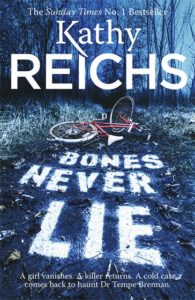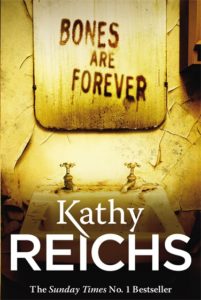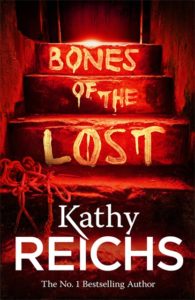Features
From the Forensic Files of Dr. Kathy Reichs
by Kathy Reichs
The ideas for my Temperance Brannan novels come from both the professional and personal parts of my life.
My professional background offers no shortage of inspiring material. Most people know what forensic anthropologists do. It’s all about bones and compromised bodies.
But here’s a surprise: Now and then my colleagues and I examine fleshed individuals, sometimes even living, breathing people.
Occasionally the subject is an adolescent whose exact age is unclear. Should he or she be tried as an adult? Granted asylum? Allowed to make his or her own medical decisions? In such cases, anthropological analysis focuses on whether the individual is above or below an age significant for legal reasons.
 Occasionally the subject has died recently but remains unidentified, and age or ethnicity is uncertain. Or the fracture patterning due to trauma is complicated. In such cases skeletal analysis can add valuable information to the soft-tissue autopsy.
Occasionally the subject has died recently but remains unidentified, and age or ethnicity is uncertain. Or the fracture patterning due to trauma is complicated. In such cases skeletal analysis can add valuable information to the soft-tissue autopsy.
Some years ago I was asked to serve as an expert adviser for a public inquiry into the 1969 death of a police detective. The man was found in his car, dead of a gunshot wound to the chest. When the manner of death was ruled suicide, the family cried foul, insisting their father/husband had been murdered for testifying about police corruption. They claimed he’d been shot in the back and that the wound on his chest was from a bullet exiting, not entering, as stated by the coroner. Twenty-seven years post mortem they found a pathologist who agreed with their version of events, based on his viewing of the old black-and-white autopsy and scene photos.
A government commission formed and a team was assembled to exhume the deceased. Michael Baden was the pathologist. I was the forensic anthropologist.
Though three decades underground had reduced the remains to bone, the fracture patterning on the sternum was classic. The bullet had entered anteriorly and exited posteriorly, taking breakaway fragments with it. Dr. Baden and I were in agreement concerning a front-to-back trajectory.
Suicide? Homicide? Not our call. But the man had not been shot in the back.
Desperate, the family’s pathologist then argued that the defect was a developmental anomaly called a sternal foramen, and, later still, that the damage was produced not by a projectile at all but by our analysis.
 To no avail. The original finding of suicide stood.
To no avail. The original finding of suicide stood.
So. Change the police detective to an Afghan man and boy. Change the question of suicide versus homicide to one of murder versus self-defense.
But why Afghanistan?
That’s where the personal enters the picture.
In the fall of 2011 I was honored and privileged to be invited by the USO (United Services Organizations) and the ITW (International Thriller Writers) to travel with Clive Cussler, Mark Bowden, Sandra Brown, and Andrew Peterson to Afghanistan and Kyrgyzstan to thank our troops for their courage and dedication. I was overwhelmed by the bravery, selflessness, and optimism of every service member I met.
My time in the Middle East remains a collage of vivid memories. Rising at five and dropping into my bunk at midnight. Trekking from our B-hut to the head with my roomie, Sandra. Plunging earthward in a pitch-black C-130J Hercules. Riding in Black Hawk helicopters with Mark Bowden, author of Black Hawk Down. (We good, Mark?) Wearing a helmet and forty pounds of body armor.
But mostly I remember the people: The army sergeant penning his first novel. The air force mother-daughter team who’d enlisted, trained, and deployed together. The marine lieutenant serving in a war zone as her baby was cutting his first teeth.
Being part of Operation Thriller II was humbling, moving, and gratifying. Before touching down stateside I’d decided to share the experience with my readers.
 In many of my books I use Tempe’s exploits to illuminate an important societal issue: The predatory nature of cults. Trafficking in endangered species. The tragedy of human rights abuse. Black marketeering in human body parts. Child pornography on the Internet.
In many of my books I use Tempe’s exploits to illuminate an important societal issue: The predatory nature of cults. Trafficking in endangered species. The tragedy of human rights abuse. Black marketeering in human body parts. Child pornography on the Internet.
My daughter Courtney Reichs Mixon is a nurse. BA, BSN, RN, ONC. (Point of information: My offspring maintain a friendly rivalry over post-signature credentialing. Though both of her siblings are attorneys, at the moment Courtney holds the lead in alphabetic certification.)
Since obtaining her RN, Courtney has pursued an interest in forensic nursing and has worked alongside sexual assault nurse examiners (SANE). She has come to understand that sexual assault victims are often severely psychologically traumatized, and she feels a particular calling to help those who have suffered as a result of human trafficking.
Courtney belongs to several organizations dedicated to this goal, including NC Stop Human Trafficking and All We Want Is Love: Liberation of Victims Everywhere. She labels soap with a trafficking hotline number for placement in hotel, motel, and truck stop bathrooms; organizes fund-raising events; answers hotline calls; and is training to be a speaker/educator for school groups, book clubs, churches, and other organizations.
It was Courtney’s passion on the subject of human 468 trafficking (along with her relentless nagging each time I started a new book) that spurred me to highlight this tragic and heart-breaking problem in Bones of the Lost.
Professional. Personal. Free-ranging data bytes in my brain. Disconnected facts, memories, and impressions reconfigured.
Voilà: a new Temperance Brennan novel is born.


Please note: Moderation is enabled and may delay your comment being posted. There is no need to resubmit your comment. By posting a comment you are agreeing to the website Terms of Use.